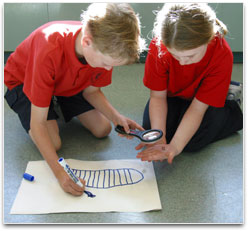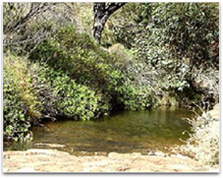Which Statement Is True For Both Plants And Animals Brainly
The environment: living and non-living things
Folio Content
This focus idea is explored through:
- Contrasting student and scientific views
- Critical teaching ideas
- Teaching activities
- Farther resources
Contrasting educatee and scientific views
Pupil everyday experience
 Students tend to retrieve of organisms equally beingness only animals that interact with the physical surround and plants, without affectionate the complex interdependence betwixt members of and across species.
Students tend to retrieve of organisms equally beingness only animals that interact with the physical surround and plants, without affectionate the complex interdependence betwixt members of and across species.
Research: Hubber & Tytler (2004)
Their ideas of ecosystems are usually only associated with natural and wilderness areas rather than their own environments. This concept of an ecosystem also influences their ideas about how humans interact with ecosystems, which is often in terms of the destruction or collapse of natural and wilderness ecosystems rather than those systems that are function of their more than immediate environments.
Enquiry: Novak & Gowin (1984)
Scientific view
The globe contains a wide diverseness of concrete conditions, which creates a diversity of environments where living things can be found. In all these environments, organisms interact and use available resources, such every bit food, infinite, light, heat, water, air, and shelter. Each population of organisms, and the individuals within information technology, collaborate in specific ways that are limited by and tin can do good from other organisms.
Interactions betwixt different organisms are numerous and are usually described according to their positive (beneficial), negative or neutral event on others.
The interactions between living things and their not living surround makes up a full ecosystem; understanding any i part of it requires knowledge of how that office interacts with the others.
Ecosystems exercise not 'collapse' merely do change in role, structure and composition over time due to natural or human disturbance (examples include the touch of drought, flooding, mowing and herbicides).
Research: Novak and Gowin (1984)
Critical teaching ideas
- All organisms exist within ecosystems.
- Living things have various structures that enable them to survive: for example, transport structures in plants allow water and trace elements to motion. Similarly there are digestive structures and respiratory structures in animals and reproductive structures in plants and animals that assist in organisms functioning within ecosystems.
- Each organism has item forms of these structures that aid their survival.
- In all environments, organisms with similar needs may compete with one some other for limited resources, including food, space, water, air and shelter.
![]() Explore the relationships between ideas about organisms and their interactions with their environments in the Concept Development Maps – (Flow of Free energy in Ecosystems,Natural Selection)
Explore the relationships between ideas about organisms and their interactions with their environments in the Concept Development Maps – (Flow of Free energy in Ecosystems,Natural Selection)
Students need to experience evidence of a functioning ecosystem with abundant plant-animal interaction to develop a better understanding of the complication of interactions and to understand that they themselves live within ecosystems.
Time is a factor that influences the blazon of interactions and changes that take place in an ecosystem. This is problematic for science planning that does non allow students to detect changes over an extended flow of time. Allowing ongoing investigations to run throughout the year is an important consideration (or alternatively use video clips that record changes over fourth dimension).
Research: Skamp (2004)
Educational activity activities
Collect bear witness/information for analysis
Identify a project within your local community where student research and involvement may have an impact.
Some examples are:
- Whale Dept. of Surround and Water Resources - Coasts and oceans
- Marine Coastal Projects
- Adopt a Dolphin - Whale and Dolphin Conservation Society
- Dolphin Enquiry Found
Inquiry: Baker (2005)
Challenge some existing ideas
In order to challenge the ideas that ecosystems only exist in wilderness areas and that human being impact is always negative, encourage students to undertake activities which allow them to investigate living things in a natural local environment such as the schoolyard, local pond, a wetland or a constructed environment such equally a classroom pond.
Research: Skamp (2004)
Collect prove/data for analysis
Studying pond animals over a period of weeks gives a sense of the changes that occur in populations every bit they collaborate or in changes of class as animals become through their lifecycles. Students can link this with a longer study to provide insights to seasonal changes and animal adaptations related to seasonal cycles. The 10 part Television series The Life of Birds completed past Sir David Attenborough in 1998 provides some neat examples of how birds have adapted to urban environments.
Inquiry: Skamp (ii004)
Focus student attention on disregarded detail
 Encourage students to tape observations and descriptions of phenomena using scientific discipline journals, labelled diagrams, timelines and PowerPoint presentations. Use microscopes and manus held lenses to assist observations of structure and function. For example you could map a schoolhouse pond or nearby wetland, rail where tadpoles are feeding and where other organisms are situated or motion in relation to each other.
Encourage students to tape observations and descriptions of phenomena using scientific discipline journals, labelled diagrams, timelines and PowerPoint presentations. Use microscopes and manus held lenses to assist observations of structure and function. For example you could map a schoolhouse pond or nearby wetland, rail where tadpoles are feeding and where other organisms are situated or motion in relation to each other.
Clarify and consolidate ideas for/by communication to others
Students could create a news report on their project or develop a projection like creating a new playground. They could explore an issue for the media or their school newsletter from differing perspectives such equally a politician, a greenie, a farmer, a parent, a local elder or other teachers. This involves ethical decision-making on behalf of the students every bit to what to include and what not to include in the report.
Further resources
Scientific discipline related interactive learning objects can be found on the FUSE Teacher Resources folio.
To admission the interactive learning object below, teachers must login to FUSE and search past Learning Resource ID:
- Ecology evaluation project: frog pond habitat –students answer a brusque quiz virtually how organisms are adapted to their environs, so explore a pond environment. They choose sampling tools suited to avert pain the animals or damaging the study area, then collect animals from a pond, grassy bank, rocky bank, trees and shrubs. They look at a species description and video for each beast and describe how the animal meets its basic needs for food, water, shelter and protection.
Learning Resource ID: R9QN9M
- Ecology evaluation project: frog pond habitat (2) – students explore why a frog population is failing by look at changes in the pond over time (specifically, h2o quality, habitat loss and predation by introduced species). Students build a food web for the swimming and model population interactions. They identify which species take the greatest touch on the frog and finally build a report using evidence collected to back up their conclusions.
Learning Resource ID: FTE6CS
Source: https://www.education.vic.gov.au/school/teachers/teachingresources/discipline/science/continuum/Pages/environment.aspx
Posted by: hydesith1974.blogspot.com

0 Response to "Which Statement Is True For Both Plants And Animals Brainly"
Post a Comment